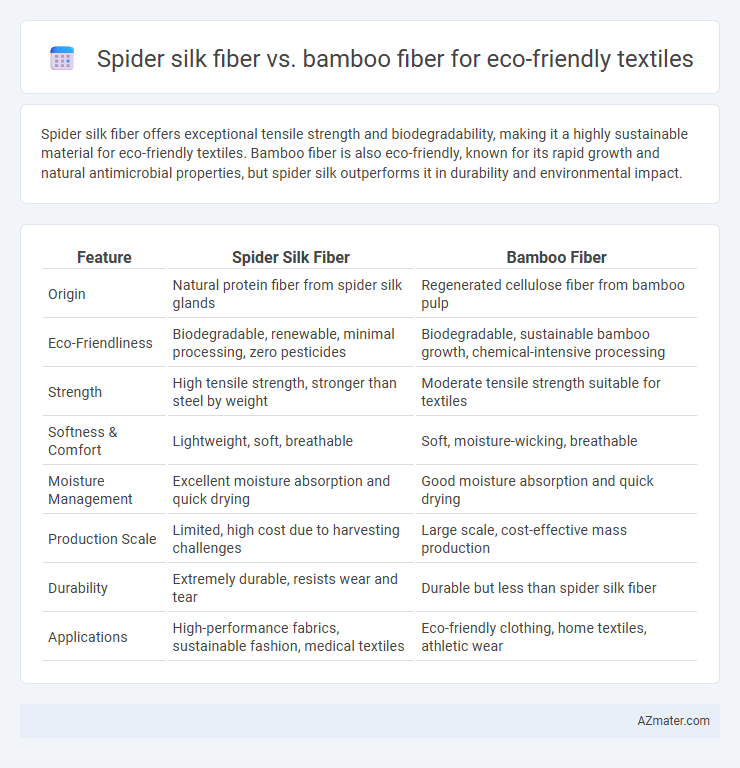Spider silk fiber offers exceptional tensile strength and biodegradability, making it a highly sustainable material for eco-friendly textiles. Bamboo fiber is also eco-friendly, known for its rapid growth and natural antimicrobial properties, but spider silk outperforms it in durability and environmental impact.
Table of Comparison
| Feature | Spider Silk Fiber | Bamboo Fiber |
|---|---|---|
| Origin | Natural protein fiber from spider silk glands | Regenerated cellulose fiber from bamboo pulp |
| Eco-Friendliness | Biodegradable, renewable, minimal processing, zero pesticides | Biodegradable, sustainable bamboo growth, chemical-intensive processing |
| Strength | High tensile strength, stronger than steel by weight | Moderate tensile strength suitable for textiles |
| Softness & Comfort | Lightweight, soft, breathable | Soft, moisture-wicking, breathable |
| Moisture Management | Excellent moisture absorption and quick drying | Good moisture absorption and quick drying |
| Production Scale | Limited, high cost due to harvesting challenges | Large scale, cost-effective mass production |
| Durability | Extremely durable, resists wear and tear | Durable but less than spider silk fiber |
| Applications | High-performance fabrics, sustainable fashion, medical textiles | Eco-friendly clothing, home textiles, athletic wear |
Introduction to Eco-Friendly Textile Fibers
Spider silk fiber offers exceptional strength, biodegradability, and lightweight properties, making it a premium choice for eco-friendly textiles. Bamboo fiber is highly sustainable due to rapid growth and natural antimicrobial qualities, providing softness and moisture-wicking benefits in eco-conscious fabric production. Both fibers contribute significantly to reducing environmental impact by minimizing resource consumption and promoting biodegradability in sustainable textile manufacturing.
Understanding Spider Silk Fiber: Properties and Production
Spider silk fiber exhibits exceptional tensile strength, elasticity, and biodegradability, making it a superior eco-friendly textile material compared to bamboo fiber. Produced through the natural spinning process of spiders, this protein-based fiber combines lightweight durability with remarkable thermal regulation and antimicrobial properties. Unlike bamboo fiber, which requires extensive chemical processing, spider silk's production involves sustainable biomimetic methods, minimizing environmental impact and enhancing textile performance.
Bamboo Fiber Overview: Nature and Manufacturing
Bamboo fiber is derived from the fast-growing bamboo plant, making it a highly renewable resource with minimal environmental impact. The manufacturing process typically involves mechanical crushing of bamboo stalks to extract cellulose, which is then spun into fiber without the use of harmful chemicals, preserving its biodegradable and antibacterial properties. Bamboo fiber's natural softness, breathability, and moisture-wicking abilities position it as a sustainable choice for eco-friendly textiles compared to synthetic or resource-intensive fibers.
Environmental Impact: Spider Silk vs Bamboo Fiber
Spider silk fiber boasts exceptional biodegradability with minimal environmental footprint due to its production relying on genetically engineered microbes, resulting in low water usage and zero pesticide application. Bamboo fiber, while renewable and fast-growing, often undergoes intensive chemical processing that can generate harmful effluents and increase pollution risks. Spider silk's sustainable manufacturing processes offer a significantly lower carbon footprint compared to conventional bamboo fiber production, making it a superior choice for eco-friendly textiles.
Strength and Durability Comparison
Spider silk fiber exhibits exceptional tensile strength and elasticity, outperforming many natural fibers, including bamboo, with tensile strength up to 1.75 GPa compared to bamboo fiber's approximate 0.4 GPa. The durability of spider silk is notable for its resistance to wear and environmental degradation, making it highly suitable for long-lasting eco-friendly textiles. In contrast, bamboo fiber, while strong and biodegradable, tends to degrade faster and has lower resistance to mechanical stress under repeated use.
Comfort and Wearability Factors
Spider silk fiber exhibits exceptional tensile strength and elasticity, offering unmatched softness and breathability compared to bamboo fiber in eco-friendly textiles. Bamboo fiber, while naturally antimicrobial and moisture-wicking, tends to be coarser and less durable, potentially affecting long-term wearability and comfort. The lightweight and smooth texture of spider silk makes it ideal for sensitive skin and high-performance apparel, ensuring superior comfort in sustainable fashion.
Biodegradability and End-of-Life Scenarios
Spider silk fiber exhibits excellent biodegradability due to its protein-based composition, breaking down naturally without leaving harmful residues, making it an ideal option for eco-friendly textiles. Bamboo fiber also offers strong biodegradability, deriving from cellulose that decomposes efficiently under composting conditions, but processing methods may affect its environmental impact. In end-of-life scenarios, spider silk fibers facilitate closed-loop recycling and safe soil integration, while bamboo fibers support composting and renewable waste recovery, both promoting sustainable textile lifecycle management.
Scalability and Commercial Availability
Spider silk fiber exhibits exceptional strength and biodegradability but faces significant challenges in scalability and commercial availability due to complex extraction and high production costs. Bamboo fiber, derived from rapidly renewable bamboo plants, offers greater scalability with widespread cultivation and established production techniques, making it more commercially accessible for eco-friendly textiles. While spider silk remains a niche luxury material, bamboo fiber dominates in mass-market sustainable textiles due to its cost-effective processing and abundance.
Ethical and Social Considerations
Spider silk fiber production involves limited environmental disruption and supports animal welfare by utilizing synthetic or farmed silk rather than harming spiders, promoting ethical textile practices. Bamboo fiber offers a sustainable alternative due to its rapid growth and low pesticide requirement but raises concerns over chemical-intensive processing methods that may impact worker health and local communities. Both fibers provide opportunities for fair labor practices, yet transparency in sourcing and manufacturing remains crucial to ensuring positive social outcomes in eco-friendly textile production.
Conclusion: Which Fiber Leads Sustainable Fashion?
Spider silk fiber offers unmatched strength, biodegradability, and a minimal environmental footprint due to its natural protein composition and low-energy production process. Bamboo fiber provides renewable sourcing and antibacterial properties but involves chemical-intensive treatments that challenge its sustainability claims. Therefore, spider silk fiber leads sustainable fashion by combining superior eco-friendly attributes with innovative production technology that supports a circular textile economy.

Infographic: Spider silk fiber vs Bamboo fiber for Eco-friendly textile
 azmater.com
azmater.com